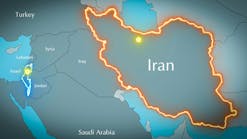MIDSTREAM ACTIVITY "HEALTHY" IN 2Q
Second quarter numbers for the midstream sector looked healthy, noted Tortoise Capital Advisors in a mid-year review. New projects were placed in service during the quarter with additional projects scheduled to commence later in 2015 and 2016. "Our projection for capital investment in MLP, pipeline and related organic growth projects through 2017 remains strong at approximately $160 billion." On M&A activity in the space, Tortoise Capital Advisors tallied MLP and pipeline transactions totaling approximately $30 billion in the second quarter, adding to the $60 billion in activity so far this year. The firm also noted support for MLP and pipeline companies from capital markets. The quarter saw an equity raise of more than $6 billion and debt to the tune of $12 billion, with a year-to-date total over $49 billion, they noted.
NEXTERA EYES SOUTH TEXAS GAS LINES
NextEra has entered into an agreement to acquire seven natural gas pipelines in Texas from privately-held NET Midstream. The deal covers seven pipelines that carry gas under ship-or-pay contracts covering a total of 3 bcf/d, serving power producers and municipalities in South Texas, processing plants and producers in the Eagle Ford shale, and customers around Houston.
The portfolio consists of:
- The NET Mexico Pipeline, a 120-mile, 42-in.-diameter pipeline that delivers natural gas from the Eagle Ford to the Mexico border under a 20-year ship-or-pay contract with a Pemex subsidiary, which owns a 10% and interconnects at the US and Mexico border
- The Eagle Ford Pipeline, a 158-mile, large-diameter natural gas pipeline in the Eagle Ford. The system connection to the Agua Dulce Hub, with access to multiple pipeline interconnects.
- The Monument Pipeline, a 156-mile, 16-in. pipeline that transports gas from the Katy Hub to the city gates of Houston, as well as to the Houston Ship Channel and Galveston County.
- Four smaller Texas pipelines serving various power plants and residential customers.
The transaction is valued at $2.1 billion and includes initial consideration of $1.8 billion, which NextEra Energy Partners expects to be financed, in part, by $600 million of non-amortizing debt secured by the acquired assets. The transaction also contemplates a future expansion investment of $300 million in 2016, expected to be financed primarily with debt. Overall, permanent financing is expected to consist of $1.2 billion of equity and $900 million of debt.
NextEra Energy Partners expects the acquisition to contribute 2016 adjusted EBITDA and CAFD of $145 million to $155 million and $110 million to $120 million, respectively. If the expansion projects are completed as planned, the acquisition is expected to contribute 2018 adjusted EBITDA and CAFD of $190 million to $210 million and $135 million to $155 million, respectively.
ENCAP FLATROCK SUPPLIES $300M TO FORM RANGELAND ENERGY II
Rangeland Energy has secured an equity commitment of $300 million from EnCap Flatrock Midstream and management to support the formation of a new entity, Rangeland Energy III LLC. Rangeland III plans to pursue new midstream opportunities in resource plays across North America.
The $300 million equity commitment is the third commitment EnCap Flatrock has made to a Rangeland company, bringing the total to more than $600 million since Sugarland, TX-based Rangeland's formation in late 2009.
The first Rangeland entity established the COLT System, a crude oil terminaling and pipeline system in the Bakken Shale. That company was acquired in late 2012 by Inergy Midstream LP (now Crestwood Midstream Partners LP).
PIPELINE PROJECT DELAYS AFFECT INDUSTRY OUTLOOK
In a recent report looking at the prospects for the onshore pipelines construction business and values the future markets through to 2019, Douglas-Westwood noted that, in general, modest growth is expected due to the negative impact the significant fall in oil prices has had on the onshore pipeline market, although most project delays are in North America.
The pipeline market itself is well-cushioned from short-term commodity price fluctuations with projects typically responsive to long-term demand and supply trends, both within and between regions, according to the report.
Douglas-Westwood expects onshore pipeline expenditure to grow modestly to US$220 billion between 2015 and 2019, an increase of 14% compared with $193 billion over the preceding five-year period. An increasing volume of pipeline installations is expected in most regions, supported by continued product demand growth in both new and existing population centers, new and increasing hydrocarbon supply, and a shift in energy demand preferences towards gas.
North America and Asia remain the highest volume markets, together accounting for about 45% of global capex. However, substantial growth is anticipated in the Middle East. In total, DW expects almost 309,000 kilometers (about 192,000 miles) of line pipe to be installed. This represents an increase of 11% compared to the previous five-year period.
With an anticipated 35% increase in global energy demand between 2010 and 2040, natural gas is expected to significantly increase its share of the energy mix - growing by 65% over the same period. This trend is progressing as expected, driven in large part by non-OECD demand growth and technology advancements, including in liquefied natural gas.
Investment in new infrastructure to support LNG and unconventional gas developments will be a major factor shaping future demand for pipelines. Outside the major oil province of the Middle East, gas pipelines accounted for 62% of kilometers installed over the past five years with this figure expected to increase to 66% for the 2015-2019 period.
The Douglas-Westwood report notes that lower steel prices and greater manufacturing capacity have become available. Lower levels of near-term activity among tubular goods providers have released manufacturing capacity for line pipes. Lower-than-expected economic growth in Asia and reduced activity in North American unconventional production is expected to support this scenario in the short-term.
GLOBALDATA: NORTH AMERICA SPEARHEADING RISE IN LNG LIQUEFACTION CAPACITY GROWTH
Global liquefied natural gas capacity would more than double from 341 million tonnes per annum (mtpa) in 2015 to 811 mtpa by 2019 based on proposed natural gas liquefaction projects, according to GlobalData.
The company's latest report states that the scale of the North American project pipeline is unparalleled, totaling 32 individual liquefaction plants with over 287 mtpa of capacity through the end of the decade. Dramatic liquefaction capacity growth is also anticipated in Africa, Europe and Asia.
"Years of lobbying for regulatory approval and building out liquefaction capacity has paid off, and the global market will now have to make room for significant increasing volumes of North American gas," said Matthew Jurecky, GlobalData's Head of Oil & Gas Research and Consulting.
"Shale operators in North America have eyed international markets since 2009, when BG Group entered into a joint venture with Exco Resources in the Haynesville Shale. Shortly after, in 2010, the first application for an LNG export facility in the US was made by Cheniere, before BG announced a long-term LNG sale and purchase agreement with Cheniere in 2011.
"With Shell acquiring BG in early 2015, the global LNG leader is now also lined up behind the emerging US shale gas export market."
Jurecky adds that the capital expenditure required to execute the planned global projects is estimated at approximately $700 billion, almost half of which is allocated to projects in North America.
The analyst also states that global LNG regasification capacity is expected to grow by around 50%, from 41 trillion cubic feet (tcf) in 2015 to 60 tcf by 2019.
Jurecky continues: "The massive growth in liquefaction is commensurate with the proposed growth in regasification capacity. Continued demand growth in Asia and an alternative to pipeline natural gas in Europe underlies the $34 billion in capital expenditure behind new LNG regasification projects.
"China and India will lead regasification additions, with a combined $20.6 billion proposed to increase regasification capacity by 7 tcf in the two countries by 2019. In Europe, Canatxx LNG Limited is planning a massive LNG import terminal in the UK with a total capacity of over 1 tcf."
AZURE MAKES $83M DROP-DOWN DEAL WITH AZURE MIDSTREAM PARTNERS
Azure Midstream Energy LLC, a midstream natural gas gathering and processing company based in Dallas, Texas, and the 100% owner of the general partner of Azure Midstream Partners LP, has confirmed the contribution of the equity interests of Azure ETG LLC.
Consideration for the ETG contribution comprises $80 million in cash and an additional 255,319 common units in the partnership. Approximately $80 million in cash proceeds from the contribution will be used to reduce indebtedness. In January, Azure committed to reducing indebtedness by $195 million to $250 million. With the drop down of ETG, Azure will have met its 2015 debt reduction target.
The ETG system was part of Azure's Center system and includes approximately 250 miles of gathering pipelines, three owned treating plants, 10 MMcf/d of processing capacity and four interconnections with major interstate pipelines providing 1.75 bcf/d of access to downstream markets. A total of 336,000 gross acres in the Haynesville and Bossier shale formations are dedicated to ETG under 23 long-term producer contracts.
MOODY'S: MIDSTREAM OUTLOOK REVISED
Moody's Investors Service has changed its outlook for the global midstream energy industry to stable from positive on slowing EBITDA growth in 2015-16. "Deep spending cuts in the exploration and production (E&P) sector have reduced midstream spending on growth projects that underpinned our positive outlook," said Andrew Brooks, a Moody's vice president and senior analyst.

